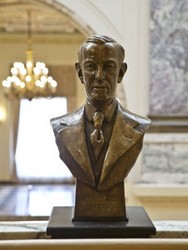The University has removed Woodrow Wilson’s name from its marquee building and renamed it to the Great Hall of Shadow Lawn in an effort to cultivate a more inclusive campus community, announced by President Leahy in a June 19 email.
“Wilson was a controversial politician, who never actually set foot in the current building,” Leahy wrote. “Removing his name, and incorporating these earlier names, connects the centerpiece of our campus more accurately to our historical roots and eliminates a symbolic barrier to the important work of creating a truly welcoming and inclusive space in the Great Hall.”
Wilson, who served as Governor of New Jersey before being elected as the 28th president of the United States, received a Nobel Peace Prize for his role as a leading architect for the League of Nations. However, he also had a history of discrimination that includes re-segregating the federal government, endorsing the Ku Klux Klan, and denying African American students admission to Princeton University where he served as president from 1902 to 1910.
“The University absolutely made the right decision to rename Wilson Hall as the Great Hall,” said Michael Corsey, Digital Content Producer for University Marketing & Communications and a 2011 and 2015 Monmouth alum. “As a person of color, I am relieved that I no longer work in the basement of a building named after a segregationist. As an alumnus, I feel like this was long overdue and while there is more work needed to make Monmouth fair and equitable for all, this is a significant step forward.”
This is not the first time that conversations have arisen about Wilson’s name being linked to the University building. The Board of Trustees voted to retain Wilson’s name on the building in 2016 because “…we have a responsibility to tell Wilson’s full story, the good and bad,” said Monmouth University Board Chair Henry Mercer.
“In some ways, Wilson was a great president. He was also a backslider on race and managed to reverse some of the gains the federal government had made toward being a just entity,” said Christopher DeRosa, Associate Professor and Chair of the History and Anthropology Department. “While understanding that those who named the building ‘Wilson Hall’ in the 1960s were not doing so to promulgate a white-supremacist agenda, it is also understandable that we today might want to use the honor of the building’s name differently.”
“Names of many things change over time. ‘Wilson Hall’ was not the building’s original name,” DeRosa continued.
Originally named Shadow Lawn, the landmark has stood as the centerpiece of Monmouth University for decades since acquiring the property in 1955 from Highland Manor Junior College. It was then renamed to the Great Hall, only to be rededicated as Woodrow Wilson Hall in 1966.
It was Wilson’s summer White House for six weeks in 1916, and was burned down in a 1927 fire before being rebuilt two years later.
A Change.org petition garnered 43 signatures to restore Wilson’s name to the building, stating, “It is of great concern to see historical figures having their names erased across the United States and elsewhere…Wilson Hall has been an important part of the culture of Monmouth University, and has in no way incited any form of discrimination or racism.”

“I signed because I wanted to let the President and the Board of Trustees know that not everyone in the community agreed with this decision,” said John Spinelli, a senior political science student. “Wilson did have a horrible perspective concerning racial equality but (in my opinion) his accomplishments were still worthy of recognition… I think the name should have stayed.”
The Board has directed the administration to honor Julian Abele’s contributions to the Great Hall, according to Leahy’s email. Abele was the lead designer of the building and one of the first professionally trained African American architects. The building was designated a National Historic Landmark by the United States Department of the Interior in 1985.
The email was sent to student and faculty inboxes on Juneteenth, which celebrates the end of slavery in the United States. After President Lincoln signed the Emancipation Proclamation in 1863, Texas had remained a slave state until July 19, 1865.
Leahy also introduced the Board’s decision to dedicate $3 million in inaugural funds to support the University’s diversity initiatives. These include diversity programming and educational initiatives, curricular and co-curricular integration, and diverse faculty and staff recruitment.
The initiatives are being implemented as the school welcomes the Class of 2024 this fall, the University’s most diverse class yet, according to Leahy.
Members of the Monmouth Student Leadership and Students for Systematic Change have pushed for the University to expand its efforts to achieve an inclusive environment for all students.
“At the height of the Black Lives Matter movement and civil unrest among people who have grown frustrated with race-based systemic oppression, Monmouth University has a responsibility to not only take accountability for its discriminatory practices but work precisely to bring them into alignment with the schools perfuse public support for low-income students and diversity and inclusion,” wrote members of the Monmouth Student Leadership in a letter addressed to Leahy.
“It will take more than the symbolic gesture of changing a building name from a former KKK endorser, or the creation of a Diversity Initiatives Fund—whose allocations will reduce to less than the equivalent of a single administrator’s salary, to even come close to a remedy for these issues,” the letter continued.
“As we have previously made clear, our University has not yet met our goals for diversity and inclusion,” Leahy’s email concluded. “These initiatives represent just a few ways that the Board of Trustees can support our ongoing efforts.”
PHOTO TAKEN by Matthew Cutillo
PHOTO TAKEN by Asbury Park Press



